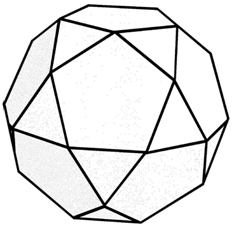As shown in Figure 1 above, a virion is composed mainly of three parts viz: the nucleic acid genome (DNA or RNA); the capsid or nucleocapsid; and the envelopes which surround the capsid or protein coat. The nucleic acid genome of a virus or virion can assume any of the following genetic composition:
- Double-stranded DNA (dsDNA)
- Single-stranded DNA (ssDNA)
- Double-stranded RNA (dsRNA)
- Single-stranded RNA (ssRNA)
Viruses assume different shapes and sizes. Morphologically, viruses have four main types of structures based on their capsid structure viz: icosahedral or cubic viruses, complex viruses and helical viruses. Some viruses however have envelops and are thus known as enveloped viruses. Icosahedral or cubic viruses have a symmetry that is in a closed shell; and typical example of viruses in this morphological group is the adenoviruses (Figure 1).
The icosahedral symmetry is exhibited by both DNA and RNA viruses. Some viruses have a spherical symmetry (Figure 2). The helical symmetry is most common amongst viruses in the orthomyxoviridae family and the tobacco mosaic viruses that infect plants also have a helical structure. Helical structure is formed when the protein subunits of the virion are bound in a periodic pattern to the viral nucleic acid in such a way that it is wound into a helix (Figure 3).
Viruses that do not show either the icosahedral or helical symmetry form a complex structure; and such viruses have an architectural plan that resembles a brick-shaped configuration with ridges on the outside and lateral bodies and core on the inside (Figure 3). Poxvirus and bacteriophages are examples of viruses that form complex symmetry.
Complex viruses as shown in Figure 4 have a tail or tube-like structure through which its nucleic acid genome is inserted into the host cell they infect. The viral nucleic acid genome (DNA or RNA) contains the genetic information of the virion and it is also responsible for directing the infectiousness of the virus.
The capsid or protein coat (which can be icosahedral, helical or complex) provides a protective function for the virion in that it protects the nucleic acid genome from enzymatic action. It is antigenic in nature, and the capsid also acts as specific binding sites that mediate binding or attachment of the virus to their host cell. The envelope consists mainly of lipid bilayers and glycoproteins which facilitate the entry of the virion into the infected host cell.

Icosahedral symmetry is an example of cubic symmetry assumed by most viruses. And the icosahedral symmetry is exhibited by both DNA-containing viruses and RNA-containing viruses. Typical examples of viruses with the icosahedral symmetry are those in the viral families: Caliciviridae, Astroviridae, Picornaviridae, Birnaviridae, Reoviridae, Parvoviridae, Polyomaviridae, Papillomaviridae, Adenoviridae, Hepadnaviridae and Bornaviridae. Viral spikes are external polypeptide projections found on the surface of viruses and which aid in the attachment or adsorption of viruses to the surface of their host cell(s). They form part of the polypeptide molecules that make up a virion. Other viral polypeptides aside viral spikes include: membrane proteins, haemagglutinins, membranes and nucleocapsid.



References
Acheson N.H (2011). Fundamentals of Molecular Virology. Second edition. John Wiley and Sons Limited, West Sussex, United Kingdom.
Alan J. Cann (2005). Principles of Molecular Virology. 4th edition. Elsevier Academic Press, Burlington, MA, USA.
Alberts B, Bray D, Johnson A, Lewis J, Raff M, Roberts K and Walter P (1998). Essential Cell Biology: An Introduction to the Molecular Biology of the Cell. Third edition. Garland Publishing Inc., New York.
Barrett J.T (1998). Microbiology and Immunology Concepts. Philadelphia, PA: Lippincott-Raven Publishers. USA.
Black, J.G. (2008). Microbiology: Principles and Explorations (7th ed.). Hoboken, NJ: J. Wiley & Sons.
Brian W.J Mahy and Mark H.C van Regenmortel (2010). Desk Encyclopedia of Human and Medical Virology. Elsevier Academic Press, San Diego, USA.
Brooks G.F., Butel J.S and Morse S.A (2004). Medical Microbiology, 23rd edition. McGraw Hill Publishers. USA.
Cann A.J (2011). Principles of Molecular Virology. Fifth edition. Academic Press, San Diego, United States.
Carter J and Saunders V (2013). Virology: Principles and Applications. Second edition. Wiley-Blackwell, New Jersey, United States.
Champoux J.J, Neidhardt F.C, Drew W.L and Plorde J.J (2004). Sherris Medical Microbiology: An Introduction to Infectious Diseases. 4th edition. McGraw Hill Companies Inc, USA.
Dimmock N (2015). Introduction to Modern Virology. Seventh edition. Wiley-Blackwell, New Jersey, United States.
Dimmock N.J, Easton A.J and Leppard K.N (2001). Introduction to modern virology. 5th edition. Blackwell Science publishers. Oxford, UK.
Discover more from Microbiology Class
Subscribe to get the latest posts sent to your email.




